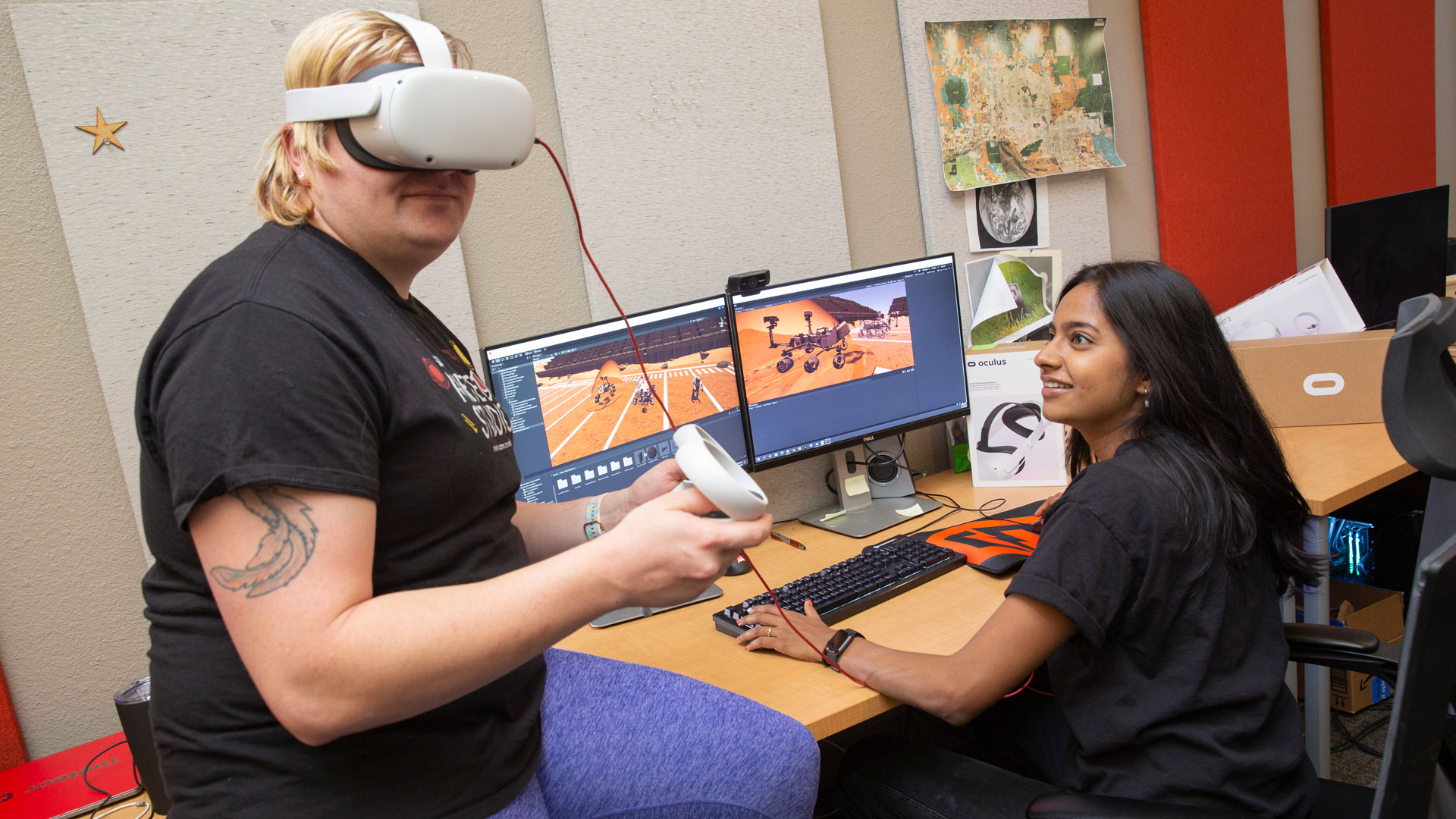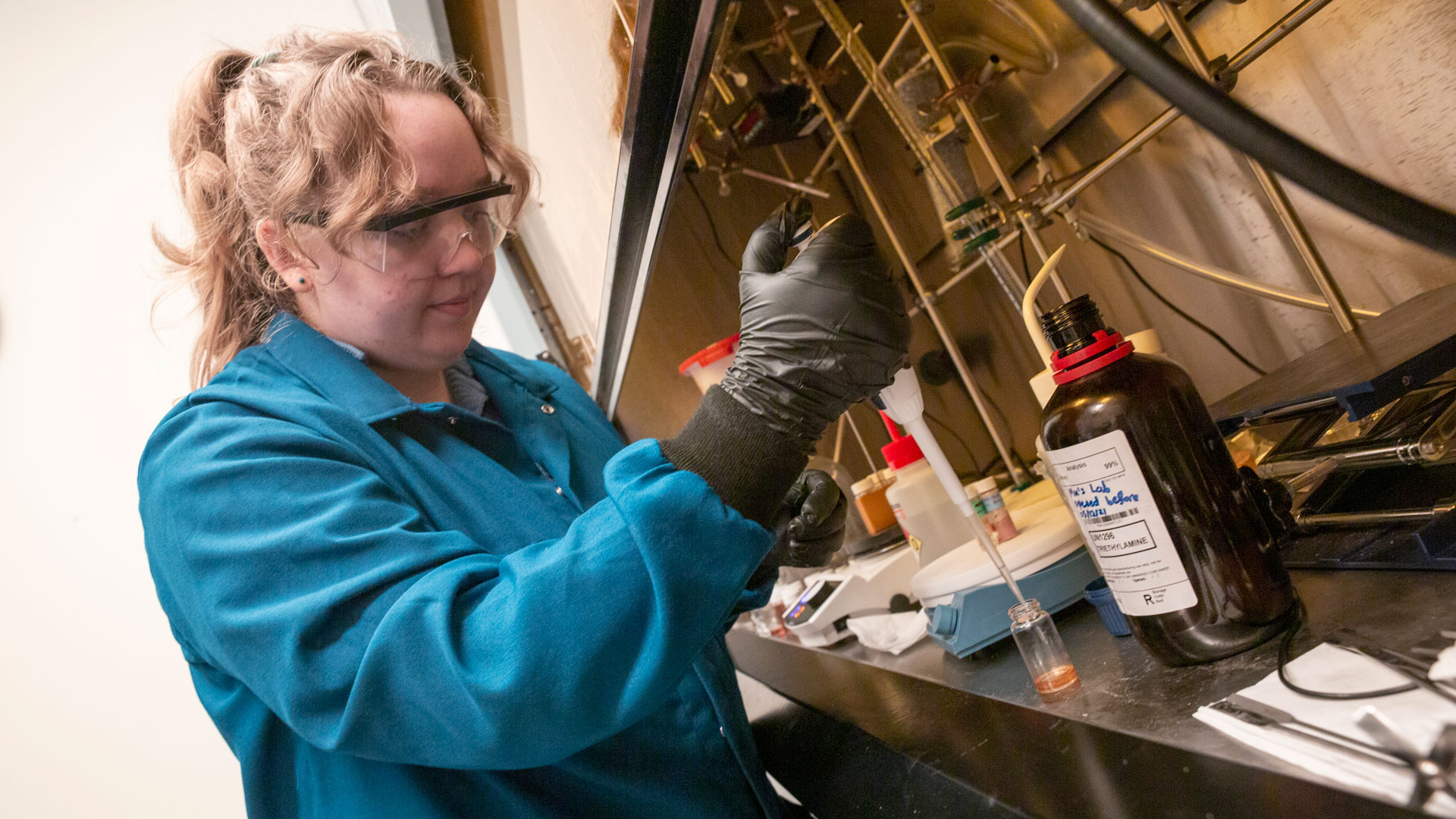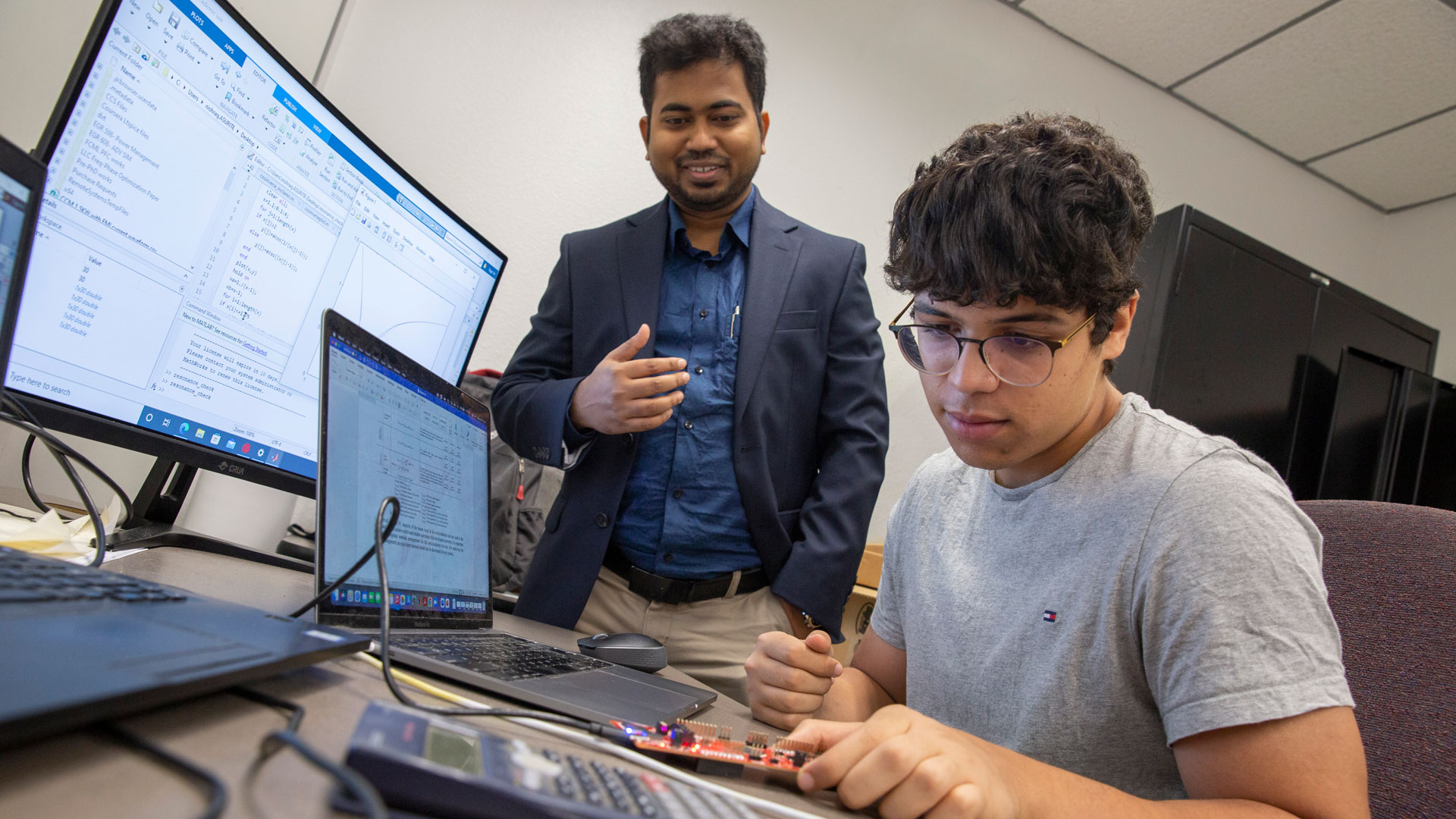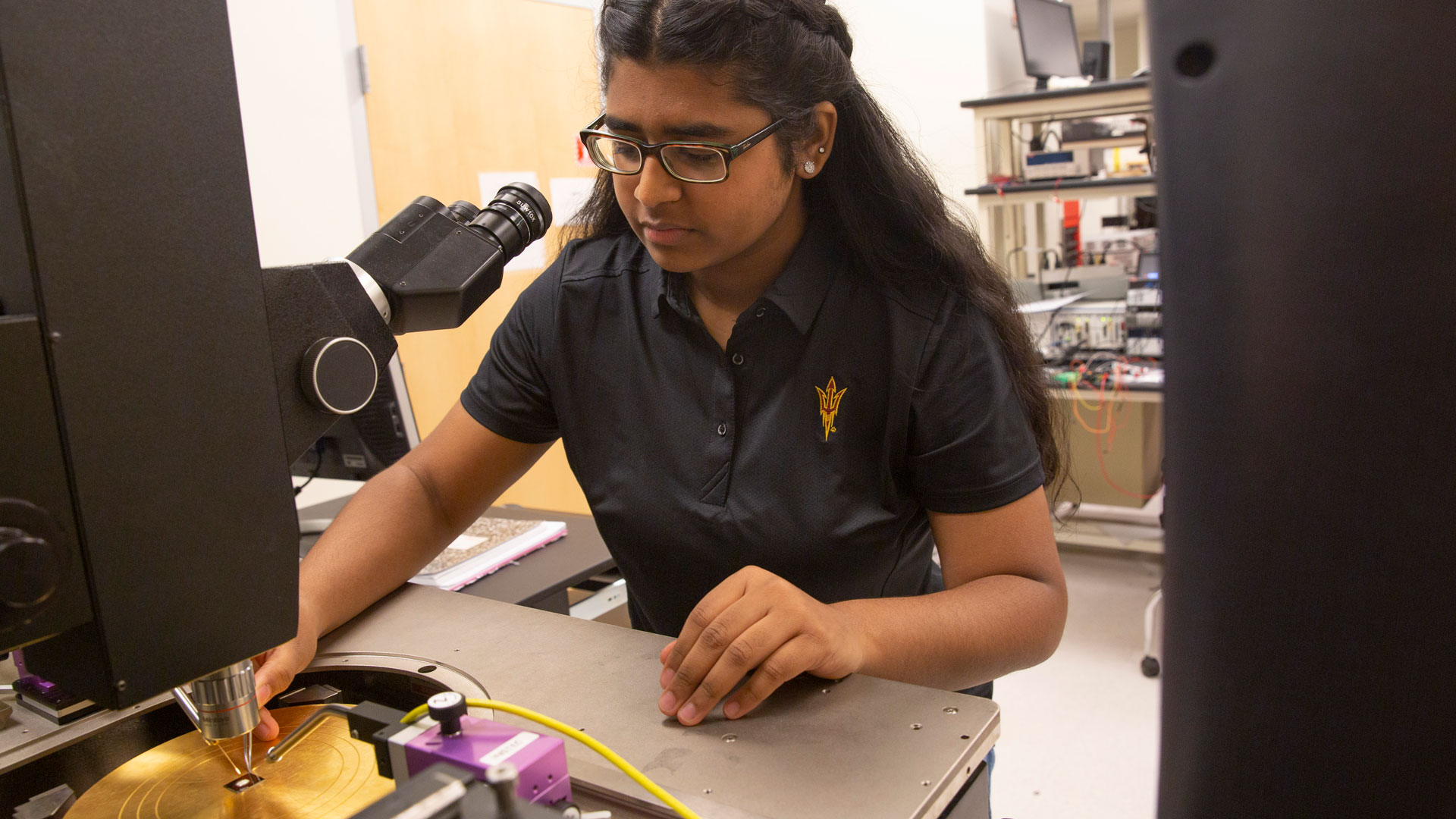Meet student researchers impacting real-world challenges

Radhika Ganapathy (right) looks at Mars rover image data with Arizona State University Meteor Studio colleague Kaycee Nienhuis, a software engineering major, as part of a research project with the Master’s Opportunity for Research in Engineering, or MORE, program to help visualize data for mission planning and other applications. Ganapathy is one of many student researchers in the Ira A. Fulton Schools of Engineering at ASU helping to solve real-world problems through hands-on research. Photo by Erika Gronek/ASU
Viewing Mars in virtual reality, developing durable and recyclable plastic, investigating electric vehicle cybersecurity and boosting brain-inspired computing are just some of the ways Arizona State University students are engaging in creative problem-solving through hands-on research.
Students in the Ira A. Fulton Schools of Engineering at ASU have a variety of opportunities to apply their classroom knowledge in diverse research pursuits. Their work is making a difference in their communities by addressing real-world challenges in data science, education, energy, health, security and sustainability.
The Fulton Undergraduate Research Initiative, or FURI, and the Master’s Opportunity for Research in Engineering, or MORE, programs give students valuable experiences in which they spend a semester conceptualizing an idea, developing a plan and investigating their research question with a faculty mentor.
Students in the Grand Challenges Scholars Program, or GCSP, have the option of conducting research as part of the program’s rigorous competency requirements that uniquely prepare them to solve complex global societal challenges.
Through these three programs, students enhance their ability to innovate, think independently and solve problems in their communities. The technical and soft skills they gain support their career and pursuits of advanced degrees.
Twice per year, students who participate in FURI, MORE and GCSP are invited to present their research findings at the FURI Symposium.
Learn about four Fulton Schools students participating in the fall 2022 FURI Symposium. Meet them and more than 60 other student investigators at the event, which is open to the public from 1 p.m. to 3 p.m. on Friday, Nov. 18, at the Sun Devil Fitness Complex on the ASU Tempe campus.
A look at some of the projects
Radhika Ganapathy
Computer science graduate student Radhika Ganapathy is building a pipeline for Mars image data to be processed and viewed in extended reality applications like virtual reality.
Images taken by Mars rovers are not viewable in their original format, so Ganapathy is working with Robert LiKamWa, an associate professor of electrical engineering in the Fulton Schools with a dual appointment in ASU's School of Arts, Media and Engineering, and LiKamWa’s Meteor Studio extended reality research lab to create a new open-source tool to view Mars rover images for a variety of applications.
Computer science graduate student Radhika Ganapathy (right) is helping people visualize Mars image data with virtual reality in her MORE research project with ASU Meteor Studio member Kaycee Nienhuis, a software engineering undergraduate student. Photo by Erika Gronek/ASU
Question: Why did you choose the project you’re working on?
Ganapathy: My interests lie in solving real-world problems related to data and human visual perception. In particular, I am inclined toward understanding the way people look at and interact with visual data. I got an opportunity to work under Dr. Robert LiKamWa and (graduate research assistant) Lauren Gold at Meteor Studios on their Mars Data Explore team. The project entailed scraping and processing planetary data to make it usable in an extended reality environment. I chose to work on this project because it was riveting and would serve as a great asset to the mixed-reality planetary projects that are in the works at ASU.
Q: How will your engineering research project impact the world?
Ganapathy: There are very few open-source tools available to scrape and access planetary data, mainly images, that are being recorded by rovers on Mars. The data that NASA publishes through the Planetary Data System is not in a viewable format. They use their native image format that requires processing before it can be used for any application.
Through the pipeline I am building, one can download and view Martian images that are being captured by the Perseverance Rover during the Mars 2020 mission. This open-source project can be used by the world to scrape Mars data and use it for various applications. Currently, the data is going to be used for the project “Mars on the Field,” a pilot project undertaken by the ASU Interplanetary Initiative. This will also be crucial for planetary scientists to conduct rover planning and prototype pilot missions in virtual reality before executing them on Mars.
Learn more about Ganapathy’s fall 2022 MORE project.
Micayla Corker
Micayla Corker is a chemical engineering junior in the FURI program working with Kailong Jin, an assistant professor of chemical engineering. She wants to reduce the proliferation of single-use plastics by modifying a recyclable polymer — a material like plastic or proteins made of very large molecules — to improve its durability for use in 3D printing and other applications where single-use plastics are the norm.
Corker’s work was also sponsored by W. L. Gore & Associates, which provides extra funding for outstanding FURI and MORE projects for one semester.
Chemical engineering junior Micayla Corker is studying recyclable polymers in her FURI project to help reduce the amount of single-use plastics used in a variety of applications, including 3D printing. Photo by Erika Gronek/ASU
Q: Why did you choose the project you’re working on?
Corker: I chose this project, which focuses on sustainable polymers for improved circularity, because I’ve always had a passion for sustainability and was interested in learning more about polymers. This project was a very hands-on way for me to combine both of those principles.
Q: How will your engineering research project impact the world?
Corker: Today, plastics have a wide variety of uses, such as fabrics in fashion, IV tubes in medicine and steering wheels in the automotive industry. However, most plastics that are produced are single-use and discarded, making up the majority of human waste per year. My research project will help combat this issue by making a recyclable polymer with the thermal and mechanical properties necessary to replace single-use plastics in various applications.
Q: How do you see this experience helping with your career goals?
Corker: My involvement in FURI and other extracurriculars will help me establish myself as someone who is excited to learn, is a dedicated student and a hard worker. I am currently looking for internships, and having experience to talk about during interviews is very helpful. Also, because I am interested in pursuing a career in materials manufacturing, my experience with polymers shows that I have a unique perspective to offer.
Learn more about Corker’s fall 2022 FURI project.
Saif Elsaady
Saif Elsaady, a sophomore in the engineering program’s electrical systems concentration, is interested in electric vehicles, or EVs.
Elsaady is conducting research on the cybersecurity of electric vehicles to help owners guard against potential cyberattacks with Ayan Mallik, an assistant professor of engineering, as part of the FURI program. He says he was surprised by the simplicity of electric vehicles and has been excited to explore how they work.
Engineering sophomore Saif Elsaady (right) is investigating the cybersecurity of electric vehicles and their chargers with Assistant Professor Ayan Mallik (left) as part of the FURI program. Photo by Erika Gronek/ASU
Q: What made you want to get involved in FURI and the project you chose?
Elsaady: The idea of learning more and expanding my network has always been of interest to me. I’ve always wanted to learn more about electric cars and the specific differences they have from internal combustion engine vehicles. I chose this project because it is an opportunity to do that.
Q: How will your engineering research project impact the world?
Elsaady: Cyberattacks are a major threat to electric vehicles and chargers. This engineering research project will help impact the world in that it will help people better prepare against cyberattacks on electric cars.
Plugging an electric vehicle into a charging station allows it to draw power from the grid. Chargers power an electric motor, which rotates the wheels, by storing the electricity in rechargeable batteries, which then provide power for the motor as needed. The microcontroller and charging system within the car are the main targets of cyberattacks in electric cars.
Attackers can use different methods to overcharge or undercharge a car’s battery, as well as obtain information regarding the owner of the vehicle from the charging station. The biggest issue I seek to address is limiting cyberattacks and ensuring EV safety and preparedness with software modifications.
Learn more about Elsaady’s fall 2022 FURI project.
Sritharini Radhakrishnan
Electrical engineering senior Sritharini Radhakrishnan is working to improve brain-inspired, or neuromorphic, computing through her FURI project with Ivan Sanchez Esqueda, an assistant professor of electrical engineering.
Her work focuses on testing a certain type of memristor, a new type of electric circuit component that retains memory even without power.
Electrical engineering Sritharini Radhakrishnan is exploring components of brain-inspired computing called memristors in her FURI research project. Photo by Erika Gronek/ASU
Q: How will your engineering research project impact the world?
Radhakrishnan: This project will make a difference in the field by providing more substantial evidence of 2D memristor array capabilities and the potential of neuromorphic computing systems.
Everyone in the field aims to advance neuromorphic computing to the point that any device using the current von Neumann computing architecture can be replaced with a neuromorphic one. To achieve such a goal, it is vital to show that the neuromorphic computing scheme is competitive with the von Neumann one by demonstrating that neuromorphic circuits can carry out complex operations faster and with greater efficiency.
My FURI project will show how an array of 2D hexagonal boron nitride (h-BN) memristor devices can perform the dot-product operation, a function common to all machine learning algorithms. To further the demonstration, the project will show that the h-BN memristor array can perform linear and logistic regression.
Q: How do you see this experience helping with your career goals?
Radhakrishnan: This experience has opened my mind to pursuing a graduate degree in engineering. Both industry and academic research are great places to practice clever thinking in the face of complex challenges. But I think the latter is better suited to me because of the space I’ll have to figure out how all the electrical engineering tools I’ve gained so far can help me become a better problem-solver.
The knowledge I gained working with h-BN memristors as a resistive random-access memory device helped me to land a memory validation internship with Intel and a research aide position working with memristor technology developed by Sandia National Laboratories with electrical engineering Associate Professor Matthew Marinella.
More Science and technology

Will this antibiotic work? ASU scientists develop rapid bacterial tests
Bacteria multiply at an astonishing rate, sometimes doubling in number in under four minutes. Imagine a doctor faced with a…

ASU researcher part of team discovering ways to fight drug-resistant bacteria
A new study published in the Science Advances journal featuring Arizona State University researchers has found…

ASU student researchers get early, hands-on experience in engineering research
Using computer science to aid endangered species reintroduction, enhance software engineering education and improve semiconductor…



